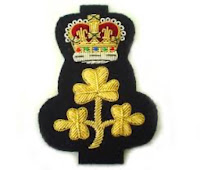 |
| Seaport Lodge (Image: Timothy Ferres, 2020) |
Portballintrae is a pretty village on the north County Antrim coast, within a few miles of the famous Giant's Causeway.
The village of Bushmills is inland, a mile or so from Portballintrae, on the River Bush.
When I was twelve years old, in 1972, we spent a few days at the Beach Hotel, which stood at a picturesque little bay named after the Salmon Rock.
 |
| The Beach Hotel, image from a picture postcard |
I have happy memories of our times there.
The hotel was demolished several decades ago for a new apartment block called, I think, the Beach Apartments.
Today Portballintrae has one hotel, a boat club, a nine-hole golf club, and a small shop and village hall at the main car-park.
I spent a few days at Portballintrae this week. After breakfast, I usually strolled past the cliffs, with their sand martins dashing in and out, to Seaport Lodge, probably the oldest building in the village, which was built about 1770.
The Lodge is a handsome building, presently being restored by its owner.
The white paint which formerly covered the stone has been stripped away, revealing the fine craftsmanship.
The building work now seems to be focussed on the interior.
 |
| Dunseverick Harbour (Image: Timothy Ferres, 2020) |
The next morning I drove along the coast to Dunseverick Harbour, a charming haven far from the madding crowd.
A winding, narrow road leads down to it, and the prospect is spectacular.
The National Trust owns part of the coast here, a spot equidistant from Portbraddan and Dunseverick Castle, popular with ramblers.
When I stopped off at the Castle (or its site; only the ruinous gate lodge remains) there were two tents there.
 |
| Lamb Cutlets at Ramore (Image: Timothy Ferres, 2020) |
In the evening I went to the popular and busy Ramore Harbour restaurant for dinner.
 |
| Portrush Harbour from Ramore (Image: Timothy Ferres, 2020) |
THE next day I went for a walk from Portballintrae to Runkerry, a distance of about two miles, where the little narrow-gauge railway begins for Bushmills.
 |
| Giant's Causeway Railway (Image: Timothy Ferres, 2020) |
It wasn't operating on Thursday, though the verges of the railway line have been trimmed and cut very recently, so perhaps it will reopen imminently.
 |
| (Image: Timothy Ferres, 2020) |
On my way home I paid a visit to Bushmills Garden Centre, where I encountered a young fox.














